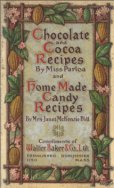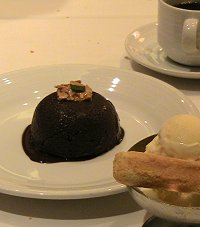Chocolate Covered Strawberries
February 2, 2010
Have you ever cut corners while cooking? Ever used short cuts that the original recipe had you make from scratch?

One thing I have learned from my experience working with chocolate is that there are some short cuts that work and some that don’t.
Read more
Healthy Chocolate
January 26, 2010
According to the USDA website, www.usda.gov, chocolate and cocoa powder contain “hefty quantities of natural antioxidants called flavonoids…..antioxidants are thought to be effective in helping to prevent cancer, heart disease, and stroke.”
How do anti-oxidants help us? “Anti”-oxidants counteract the negative effects of oxidation on our bodies. Oxidation damages cells and tissues. What is oxidation, you ask?
Read more
Spectacular Chocolate and Coffee Pairing
January 22, 2010

At one point I was rolling the two around my mouth at the same time, coffee and chocolate, chocolate and coffee... Then I experienced a new flavor emerge as I swallowed.
This got me thinking about chocolate and coffee pairings!
Read more
Chocolate Cheerios
January 18, 2010
It has been a while since I had Cheerios for breakfast. For me, Cheerios was the cereal I fed my toddler to keep him quiet in church, not something I was interested in eating for breakfast. What got my attention recently is the new Chocolate Cheerios.
 According to the Cheerios website, Chocolate Cheerios is “a perfect balance of whole grain goodness and a delicious touch of chocolate taste in every bite.”
According to the Cheerios website, Chocolate Cheerios is “a perfect balance of whole grain goodness and a delicious touch of chocolate taste in every bite.”
I am a fan of whole grain goodness, but I am even more a fan of chocolate!
Read more
Chocolate and Cocoa Recipes
January 9, 2010
 Back in 1909 Walter Baker & Co., Ltd. published a little book called Chocolate and Cocoa Recipes By Miss Parloa and Home Made Candy Recipes By Mrs. Janet McKenzie Hill.
Back in 1909 Walter Baker & Co., Ltd. published a little book called Chocolate and Cocoa Recipes By Miss Parloa and Home Made Candy Recipes By Mrs. Janet McKenzie Hill.
The staff here at Chocolate University Online have created a special 100th anniversary edition of this book and released it in a PDF download format.
Read more
Molten Chocolate Lava Cake
December 22, 2009
I recently took a cruise to the eastern Caribbean with Royal Caribbean International. Although I loved the sun, fun, and sea, what I really enjoyed were some of the most memorable desserts I have ever been eaten.

Read more
Brownie Marble Cheesecake
December 17, 2009
A few days ago Bryn mentioned a cheesecake and Pinot Grigio pairing.

Having tasted several of the wines earlier in the evening, I knew upon the first taste of the cheesecake that we would have a winning combination. Since the last of the Pinot was already in my glass I had to take it over to Bryn and tell her to taste the combination.
Read more

